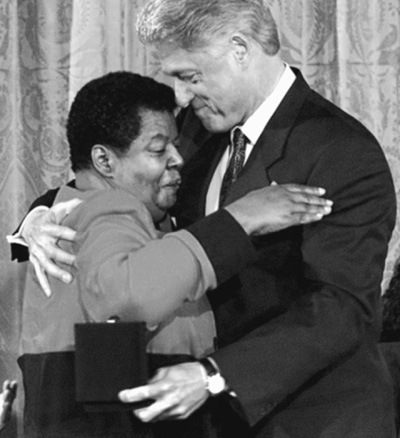
A Life Is More Than a Moment.
That was pretty much what Hazel had told Linda Monk when they first spoke over the phone. And it was what Will Counts decided to call his collection of Little Rock photographs, which was published in the fall of 1999. Counts and his wife marked the occasion in Bloomington, Indiana, where they now lived in retirement. Naturally, Elizabeth and Hazel were invited. While in town, they scheduled a series of events, including a talk with students and an interview at a local radio station.
Even before the activities began, Hazel detected frostiness from Elizabeth. Before a packed house at Indiana University, some saw discomfort in their body language. The tensions burst into the open during an interview with a local radio host named Shana Ritter. When Hazel told Ritter that her parents had pulled her out of Central for her safety, Elizabeth suddenly interjected. “Every time you say that I’m puzzled,” she said. “Who did they expect to harm you?” Hazel fumbled. Some people—L. C. Bates; Elizabeth’s father—had had guns, but Hazel didn’t want to say that on the air; it might embarrass Elizabeth. Anxiety simmered until Ritter asked for some closing thoughts. When Hazel spoke about “dialogue” and “understanding,” Elizabeth’s frustrations boiled over. “There’s a southern saying about some people peeing and calling it rain,” she said. Hazel wasn’t quite sure what that meant, but she knew it wasn’t friendly.
Vivian Counts, who had been in the studio with the two, felt like crawling out of the room. By now, she, too, was souring on Hazel—or, to be more precise, Hazel and Antoine. Over dinner one night, Antoine had complained to the Countses that everyone had made money from the picture but Hazel. It was, Hazel knew, his way of describing the pain it had caused her, which he had now witnessed, with growing impatience and frustration, for forty years. But it was certain to be taken as an attempt to cash in, and it was. Relations between the couples quickly soured; and when word of the remark reached Elizabeth (by which point Antoine’s comment had grown even balder), her own mounting skepticism was fortified. Elizabeth might be the probation officer, but it was Hazel who, for whites and blacks alike, was on perpetual probation. Returning from Bloomington, Hazel was discouraged enough to seek out Reverend Stewart. The relationship with Elizabeth wasn’t working, she told him. She wasn’t sure what to do.
Nor, for that matter, was Elizabeth. In November 1999, only a few hours after Daisy Bates was buried in Arkansas, the Nine collected their Congressional Gold Medals at a White House ceremony. Some fifty people from Little Rock attended; Elizabeth invited her sister Anna, Judge Humphrey, Ken Reinhardt, Annie Abrams, and others responsible for her “renaissance.” (Neither of her sons came.) She knew that Hazel also belonged in this group, but did not invite her: some of the other eight might object. As one of them put it, “We’re the Little Rock Nine, not the Little Rock Ten.” Oblivious to all this, Skip Rutherford provided Hazel’s name to the White House, and she eagerly accepted the invitation. Sure enough, there was static. Walking through the White House gate, Hazel spotted the least public of the Nine—Gloria Ray Karlmark, who lived in Sweden—a few feet ahead of her. “Hey Gloria!” she shouted, then walked up and introduced herself. Karlmark gave her a wilting stare. “Hah! I should have known!” she said, then walked off. Hazel was mystified. Should have known what?

Elizabeth receives a Congressional Gold Medal from President Clinton, November 1999. (Bettmann/Corbis)
Elizabeth with President Clinton in Oval Office. Also pictured are Hazel, fifth from left; Judge Marion Humphrey, fourth from left; Annie Abrams, sixth from right; and Elizabeth’s sister, Anna Goynes, sixth from left. (White House photograph, courtesy of Hazel Bryan Massery)
The medals were handed out in the East Room. Hazel beamed as Bill Clinton summoned Elizabeth to the podium. “Come here, girl!” he’d said cheerily. Friends had never seen Elizabeth so happy. She saluted the president—civilians weren’t supposed to, she knew, but she just got carried away—and he saluted back. Then they hugged for a long time. As they did, Elizabeth told him how bad she felt for not consoling him more on that flight last year back to Arkansas. Elizabeth did ask Hazel to join her guests when they posed with the president in the Oval Office. She felt sorry for her; she was in town by herself. Now there was a third picture of the two. Elizabeth didn’t keep a copy, or a complete one, anyway. Periodically, people asked for her head shot; now she had one, once she had clipped away everyone else. The medal, worth several thousand dollars, instantly constituted her life savings. Once she got it home, she tried donating it to the Smithsonian; it would spare her the cost of a safe-deposit box. Then, for a time, she kept it in the closet.
Having quickly reached her capacity for people and ceremonies, Elizabeth did not attend the reception that night at the Library of Congress. But Hazel, dauntless or clueless or needy or naïve, did, and it was a redo of her class reunion. When she asked Ernest Green for his autograph, he seemed bemused. Convinced that Hazel was out only for publicity, or to show everyone that she was a “new woman,” Gloria Ray Karlmark gave her the brush-off. Only Minnijean was really friendly; her son Isaiah asked Hazel to pose with his mother and siblings in front of Counts’s original photograph. Hazel happily obliged.